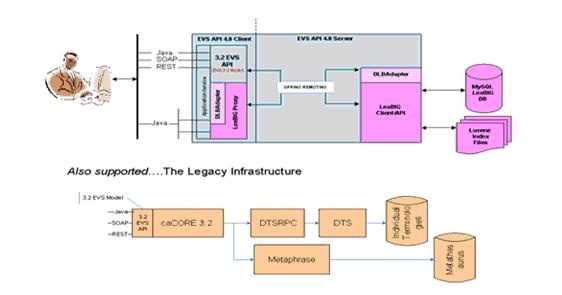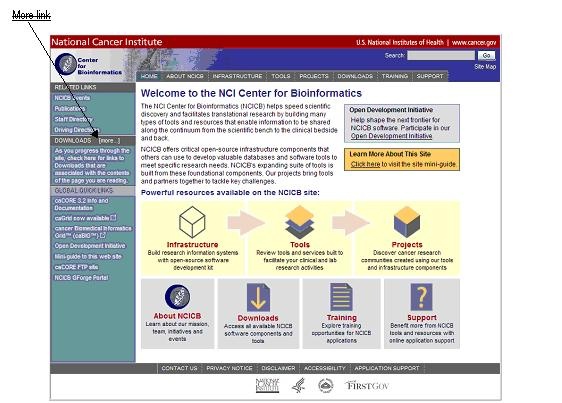 |
Page History
...
This section describes the components of the caCORE LexEVS and the service interface layer provided by the EVS API architecture. It gives examples of how to use the EVS APIs. It also describes the Distributed LexBIG API and the Distributed LexBIG Adapter.
caCORE LexEVS Components
The caCORE LexEVS API is a public domain, open source wrapper that provides full access to the LexBIG Terminology Server. LexBIG hosts the NCI Thesaurus, the NCI Metathesaurus, and several other vocabularies. Java clients accessing the NCI Thesaurus and Metathesaurus vocabularies communicate their requests via the open source caCORE LexEVS APIs, as shown in Overview of the caCORE LexEVS 4.0 release components.
Figure 4.1 - Overview of the caCORE LexEVS 4.0 release components
The open source interfaces provided as part of caCORE LexEVS 5.x include Java APIs, a SOAP interface, and an HTTP REST interface. The Java APIs are based on the EVS 3.2 object model and the LexBIG Service object model.
...
The only difference between the EVS 3.2 API exposed as part of the caCORE LexEVS 5.x and the API exposed as part of caCORE 3.2 is the back-end terminology server used to retrieve the vocabulary data. The interface (API calls) are the same and should only require minor adjustments to user applications.
| Info | ||
|---|---|---|
|
...
...
You cannot integrate caCORE 3.2 components with caCORE LexEVS 5.x. If you used multiple components of caCORE 3.2 (for example, EVS with caDSR), you need to continue to work with the caCORE 3.2 release until the other caCORE 4.0 components are available. |
The LexBIG object model was developed by the Mayo Clinic. In its native form, the associated API assumes a local, non-distributed means of access. With caCORE LexEVS 5.x, a proxy layer enables EVS API clients to access the native LexBIG API from anywhere without having to worry about the underlying data sources. This is called the Distributed LexBIG (DLB) API.
The DLB Adapter is another option for caCORE LexEVS 5.x clients who choose to interface directly with the LexBIG API. This is essentially a set of convenience methods intended to simplify the use of the LexBIG API. For example, a series of method calls against the DLB API might equate to a single method call to the DLB Adapter.
| Info | ||
|---|---|---|
|
...
...
The DLB Adapter is not intended to represent a complete set of convenience methods. As part of the caCORE LexEVS 5.x release, the intention is that users will work with the DLB API and suggest useful methods of convenience to the EVS Development Team. |
LexEVS Data Sources
The LexEVS data source is the open source LexBIG terminology server. EVS clients interface with the LexBIG API to retrieve desired vocabulary data. The EVS provides the NCI with services and resources for controlled biomedical vocabularies, including the NCI Thesaurus and the NCI Metathesaurus.
NCI Thesaurus
The NCI Thesaurus is composed of over 27,000 concepts represented by about 78,000 terms. The Thesaurus is organized into 18 hierarchical trees covering areas such as Neoplasms, Drugs, Anatomy, Genes, Proteins, and Techniques. These terms are deployed by the NCI in its automated systems for uses such as key wording and database coding.
NCI Metathesaurus
The NCI Metathesaurus maps terms from one standard vocabulary to another, facilitating collaboration, data sharing, and data pooling for clinical trials and scientific databases. The Metathesaurus is based on the Unified Medical Language System (UMLS) developed by the National Library of Medicine (NLM). It is composed of over 70 biomedical vocabularies.
Installing and Configuring the LexEVS 5.0 Java API
The LexEVS 5.0 Java API bundled with the caCORE LexEVS 5.x release provides direct access to domain objects and all service methods. Because caCORE LexEVS is natively built in Java, this API provides the fullest set of features and capabilities.
The EVS API home page provides a user interface (UI) to the Java API. The interface is available at http://lexevsapi.nci.nih.gov/lexevsapi50![]() .
.
...
| Info | ||
|---|---|---|
| ||
The caCORE 3.2 release also provides an EVS 3.2 Java client API. The difference between the 3.2 and the 4.x clients is the back-end terminology server. caCORE 3.2 uses the proprietary Apelon DTS and caCORE LexEVS 4.x uses LexBIG. The API is the same and should only require minor updates to a client application wanting to migrate to the EVS 3.2 Java API provided with caCORE LexEVS 5.x. |
Software Requirements
The caCORE LexEVS Java 3.2 API uses the following software on the client machine (caCORE LexEVS Java API client software).
Software | Version | Required? |
|---|---|---|
Java 2 Platform Standard Edition Software 5.0 Development Kit (JDK 5.0) | 1.5.0 or higher | Yes |
Apache Ant | 1.6.5 or higher | Yes |
...
Downloading the Java API Client Package
...
- Using your browser, go to http://ncicb.nci.nih.gov
 .
. - On the left navigation bar of the NCICB welcome page, click the more link to the right of the DOWNLOADS category (Downloads section of the NCICB Web site).
Figure 4.3 - Downloads section of the NCICB Web site - When prompted, enter your name, e-mail address, and institution name. #Click
- Click Enter the Download Area.
- Read and accept the license agreement.
- On the caCORE LexEVS downloads page, download the EVS Zip file from the Primary Distribution section.
Installing the Package
After downloading the caCORE LexEVS client package, extract the contents of the downloadable archive to a directory on your hard drive (for example, c:\evsapi on Windows or /usr/local/evsapi on Linux).
The extraction includes the directories and files listed in Extracted directories and files in caCORE LexEVS client package.
Directory | Files | Description | Component |
|---|---|---|---|
| | Ant build file | Build file |
| |
...
|
...
| |
...
| Logging utilities configuration properties |
...
| |||
| {{spring.jar }} | Spring framework | HTTP remoting |
...

